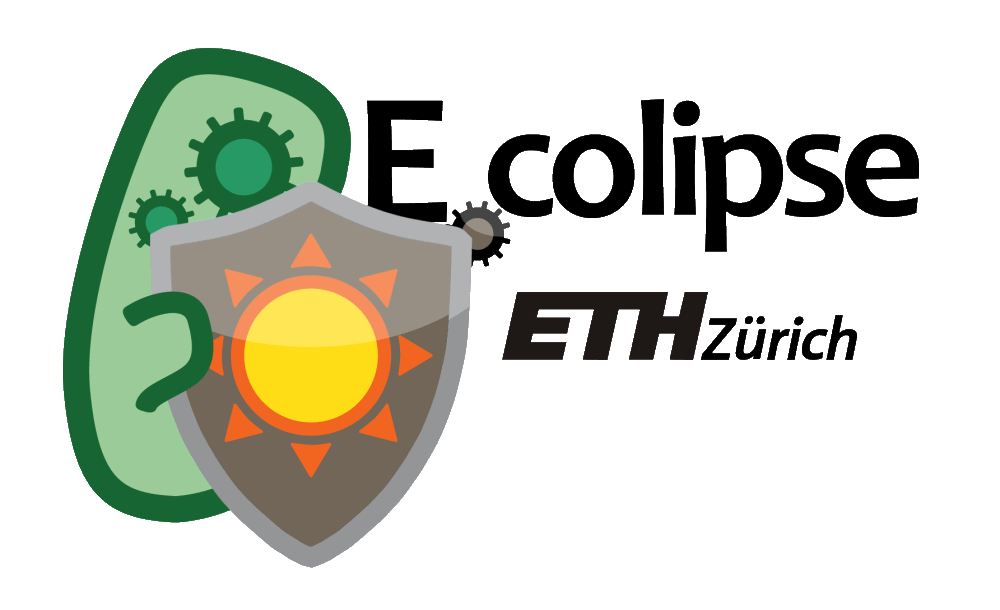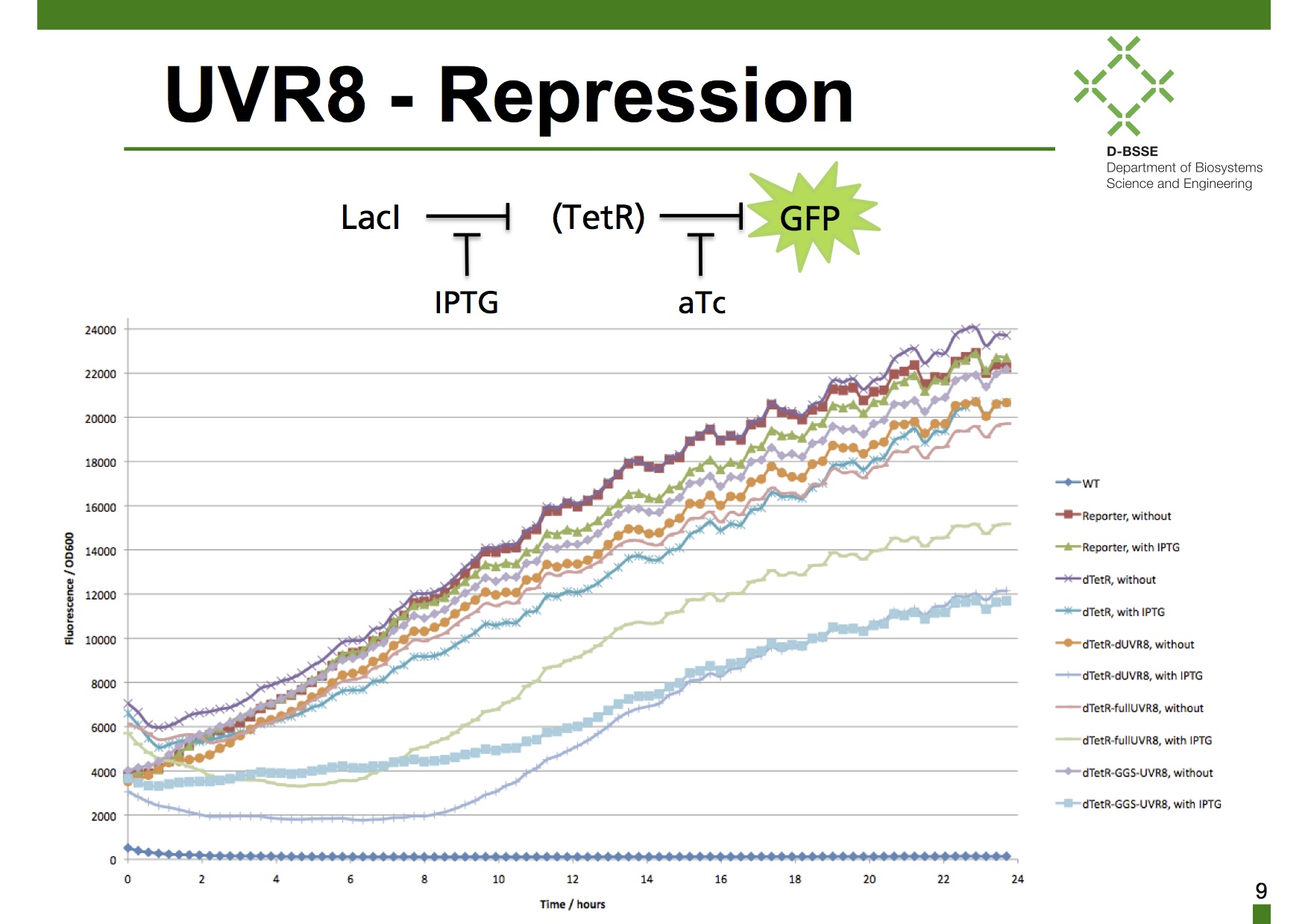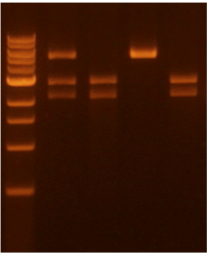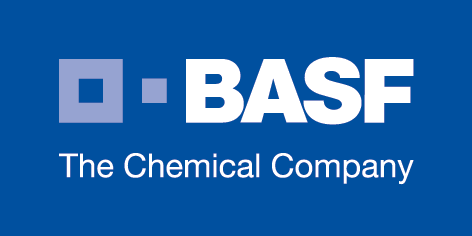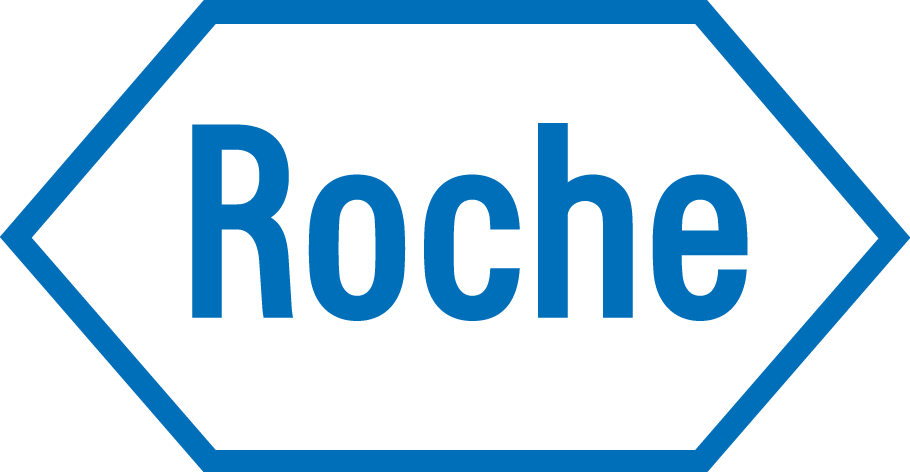Team:ETH Zurich/Results
From 2012.igem.org
| (17 intermediate revisions not shown) | |||
| Line 7: | Line 7: | ||
==== Results ==== | ==== Results ==== | ||
| + | We tested the LovTap construct with RFP as an output. Light activated LovTap is supposed to act as a repressor at the Trp operator and therefore we would expect a reduction of the RFP signal. Measurements with the plate reader lead to confusing results, therefore we switch to single cell analysis with FACS. The results show a decrease of RFP the first 5 hours, which might be due to the inoculation and RFP maturation. | ||
[[File:Lovv.jpg|frameless|500px|center]] | [[File:Lovv.jpg|frameless|500px|center]] | ||
| + | |||
| + | If we compare the signal strength of the negative control: reporter only, in the two different conditions, light and no light, we are not expecting a decrease of RFP. The decrease of RFP shown in Fig is a result of bleaching the RFP. Also for the LovTap construct we see a different output between the two conditions, but this is most probably also due to bleaching. | ||
| + | |||
==== Plans ==== | ==== Plans ==== | ||
| + | Since we are not able to get reliable results due to bleaching, we are switching our read-out system so that we will have a Galactosidase as an output. As a next step we will measure the LovTap construct in the same conditions using a Miller assay. | ||
| + | Also an important change we would like to make is to invert the signal output, which means that we are not repressing our output with blue light but activating it instead. (see constructs) We are working on cloning this construct and will test it soon. | ||
=== UVR8 === | === UVR8 === | ||
==== Results ==== | ==== Results ==== | ||
| - | |||
| + | ===== SDS PAGE ===== | ||
| + | ===== Repression studies ===== | ||
| + | [[File:Uvrr.jpg|frameless|500px|center]] | ||
| + | Colonies were cultivated in the dark in the TECAN plate reader during 24 hours and GFP fluorescence intensity was measured during that time. It turned out that the fusion strategy 1 (full UVR8 directly fused to dTetR) represses most in the dark state. | ||
==== Plans ==== | ==== Plans ==== | ||
| - | UV response | + | In a next step we plan to measure also the derepression of the UVR8 dTetR fusion by screening its UV response with the plate reader and carry out single cell analysis by FACS and finally join UVR8 and pABA systems/RecA and show increased ''E.coli'' UV-B tolerance (sun cream properties). |
| - | + | ||
| - | FACS | + | |
UVR8 fusion purification: | UVR8 fusion purification: | ||
| Line 33: | Line 40: | ||
etc. | etc. | ||
| - | + | ||
=== p-ABA generator === | === p-ABA generator === | ||
| - | + | ==== Results ==== | |
{| border="0" | {| border="0" | ||
| Line 45: | Line 52: | ||
|style="width: 210px"|[[File:Eth ladder paba.jpg|center|frameless]] | |style="width: 210px"|[[File:Eth ladder paba.jpg|center|frameless]] | ||
|- | |- | ||
| - | |Ladder, A NheI/PstI, A XbaI/PstI, B NheI/PstI, B XbaI/PstI | + | |''Ladder, A NheI/PstI, A XbaI/PstI, B NheI/PstI, B XbaI/PstI'' |
|} | |} | ||
| - | As the promoter | + | As the promoter <partinfo>BBa_J23100</partinfo> has two NheI restriction sites, construct A is cut twice (lane 2) while the promoterless construct B is cut only once (lane 4). |
| + | |||
| + | ==== Plans ==== | ||
| + | |||
| + | Cloning of B downstream of 1. the Tet promoter and 2. the PL dual input promoter <partinfo>BBa_K909011</partinfo> containing the TetO1 and LacO1 operator sites. | ||
| + | |||
| + | |||
Latest revision as of 09:17, 25 September 2012
Contents |
Results
LovTAP
Results
We tested the LovTap construct with RFP as an output. Light activated LovTap is supposed to act as a repressor at the Trp operator and therefore we would expect a reduction of the RFP signal. Measurements with the plate reader lead to confusing results, therefore we switch to single cell analysis with FACS. The results show a decrease of RFP the first 5 hours, which might be due to the inoculation and RFP maturation.
If we compare the signal strength of the negative control: reporter only, in the two different conditions, light and no light, we are not expecting a decrease of RFP. The decrease of RFP shown in Fig is a result of bleaching the RFP. Also for the LovTap construct we see a different output between the two conditions, but this is most probably also due to bleaching.
Plans
Since we are not able to get reliable results due to bleaching, we are switching our read-out system so that we will have a Galactosidase as an output. As a next step we will measure the LovTap construct in the same conditions using a Miller assay. Also an important change we would like to make is to invert the signal output, which means that we are not repressing our output with blue light but activating it instead. (see constructs) We are working on cloning this construct and will test it soon.
UVR8
Results
SDS PAGE
Repression studies
Colonies were cultivated in the dark in the TECAN plate reader during 24 hours and GFP fluorescence intensity was measured during that time. It turned out that the fusion strategy 1 (full UVR8 directly fused to dTetR) represses most in the dark state.
Plans
In a next step we plan to measure also the derepression of the UVR8 dTetR fusion by screening its UV response with the plate reader and carry out single cell analysis by FACS and finally join UVR8 and pABA systems/RecA and show increased E.coli UV-B tolerance (sun cream properties).
UVR8 fusion purification: In vitro studies
Find constants for: Dimerization Monomerization DNA binding etc.
p-ABA generator
Results
| agarose gel |
| Ladder, A NheI/PstI, A XbaI/PstI, B NheI/PstI, B XbaI/PstI |
As the promoter <partinfo>BBa_J23100</partinfo> has two NheI restriction sites, construct A is cut twice (lane 2) while the promoterless construct B is cut only once (lane 4).
Plans
Cloning of B downstream of 1. the Tet promoter and 2. the PL dual input promoter <partinfo>BBa_K909011</partinfo> containing the TetO1 and LacO1 operator sites.
References
- Brown, B. a, Headland, L. R., & Jenkins, G. I. (2009). UV-B action spectrum for UVR8-mediated HY5 transcript accumulation in Arabidopsis. Photochemistry and photobiology, 85(5), 1147–55.
- Christie, J. M., Salomon, M., Nozue, K., Wada, M., & Briggs, W. R. (1999): LOV (light, oxygen, or voltage) domains of the blue-light photoreceptor phototropin (nph1): binding sites for the chromophore flavin mononucleotide. Proceedings of the National Academy of Sciences of the United States of America, 96(15), 8779–83.
- Christie, J. M., Arvai, A. S., Baxter, K. J., Heilmann, M., Pratt, A. J., O’Hara, A., Kelly, S. M., et al. (2012). Plant UVR8 photoreceptor senses UV-B by tryptophan-mediated disruption of cross-dimer salt bridges. Science (New York, N.Y.), 335(6075), 1492–6.
- Cloix, C., & Jenkins, G. I. (2008). Interaction of the Arabidopsis UV-B-specific signaling component UVR8 with chromatin. Molecular plant, 1(1), 118–28.
- Cox, R. S., Surette, M. G., & Elowitz, M. B. (2007). Programming gene expression with combinatorial promoters. Molecular systems biology, 3(145), 145. doi:10.1038/msb4100187
- Drepper, T., Eggert, T., Circolone, F., Heck, A., Krauss, U., Guterl, J.-K., Wendorff, M., et al. (2007). Reporter proteins for in vivo fluorescence without oxygen. Nature biotechnology, 25(4), 443–5
- Drepper, T., Krauss, U., & Berstenhorst, S. M. zu. (2011). Lights on and action! Controlling microbial gene expression by light. Applied microbiology, 23–40.
- EuropeanCommission (2006). SCIENTIFIC COMMITTEE ON CONSUMER PRODUCTS SCCP Opinion on Biological effects of ultraviolet radiation relevant to health with particular reference to sunbeds for cosmetic purposes.
- Elvidge, C. D., Keith, D. M., Tuttle, B. T., & Baugh, K. E. (2010). Spectral identification of lighting type and character. Sensors (Basel, Switzerland), 10(4), 3961–88.
- GarciaOjalvo, J., Elowitz, M. B., & Strogatz, S. H. (2004). Modeling a synthetic multicellular clock: repressilators coupled by quorum sensing. Proceedings of the National Academy of Sciences of the United States of America, 101(30), 10955–60.
- Gao Q, Garcia-Pichel F. (2011). Microbial ultraviolet sunscreens. Nat Rev Microbiol. 9(11):791-802.
- Goosen N, Moolenaar GF. (2008) Repair of UV damage in bacteria. DNA Repair (Amst).7(3):353-79.
- Heijde, M., & Ulm, R. (2012). UV-B photoreceptor-mediated signalling in plants. Trends in plant science, 17(4), 230–7.
- Hirose, Y., Narikawa, R., Katayama, M., & Ikeuchi, M. (2010). Cyanobacteriochrome CcaS regulates phycoerythrin accumulation in Nostoc punctiforme, a group II chromatic adapter. Proceedings of the National Academy of Sciences of the United States of America, 107(19), 8854–9.
- Hirose, Y., Shimada, T., Narikawa, R., Katayama, M., & Ikeuchi, M. (2008). Cyanobacteriochrome CcaS is the green light receptor that induces the expression of phycobilisome linker protein. Proceedings of the National Academy of Sciences of the United States of America, 105(28), 9528–33.
- Kast, Asif-Ullah & Hilvert (1996) Tetrahedron Lett. 37, 2691 - 2694., Kast, Asif-Ullah, Jiang & Hilvert (1996) Proc. Natl. Acad. Sci. USA 93, 5043 - 5048
- Kiefer, J., Ebel, N., Schlücker, E., & Leipertz, A. (2010). Characterization of Escherichia coli suspensions using UV/Vis/NIR absorption spectroscopy. Analytical Methods, 9660. doi:10.1039/b9ay00185a
- Kinkhabwala, A., & Guet, C. C. (2008). Uncovering cis regulatory codes using synthetic promoter shuffling. PloS one, 3(4), e2030.
- Krebs in Deutschland 2005/2006. Häufigkeiten und Trends. 7. Auflage, 2010, Robert Koch-Institut (Hrsg) und die Gesellschaft der epidemiologischen Krebsregister in Deutschland e. V. (Hrsg). Berlin.
- Lamparter, T., Michael, N., Mittmann, F., & Esteban, B. (2002). Phytochrome from Agrobacterium tumefaciens has unusual spectral properties and reveals an N-terminal chromophore attachment site. Proceedings of the National Academy of Sciences of the United States of America, 99(18), 11628–33.
- Levskaya, A. et al (2005). Engineering Escherichia coli to see light. Nature, 438(7067), 442.
- Mancinelli, A. (1986). Comparison of spectral properties of phytochromes from different preparations. Plant physiology, 82(4), 956–61.
- Nakasone, Y., Ono, T., Ishii, A., Masuda, S., & Terazima, M. (2007). Transient dimerization and conformational change of a BLUF protein: YcgF. Journal of the American Chemical Society, 129(22), 7028–35.
- Orth, P., & Schnappinger, D. (2000). Structural basis of gene regulation by the tetracycline inducible Tet repressor-operator system. Nature structural biology, 215–219.
- Parkin, D.M., et al., Global cancer statistics, 2002. CA: a cancer journal for clinicians, 2005. 55(2): p. 74-108.
- Rajagopal, S., Key, J. M., Purcell, E. B., Boerema, D. J., & Moffat, K. (2004). Purification and initial characterization of a putative blue light-regulated phosphodiesterase from Escherichia coli. Photochemistry and photobiology, 80(3), 542–7.
- Rizzini, L., Favory, J.-J., Cloix, C., Faggionato, D., O’Hara, A., Kaiserli, E., Baumeister, R., et al. (2011). Perception of UV-B by the Arabidopsis UVR8 protein. Science (New York, N.Y.), 332(6025), 103–6.
- Roux, B., & Walsh, C. T. (1992). p-aminobenzoate synthesis in Escherichia coli: kinetic and mechanistic characterization of the amidotransferase PabA. Biochemistry, 31(30), 6904–10.
- Strickland, D. (2008). Light-activated DNA binding in a designed allosteric protein. Proceedings of the National Academy of Sciences of the United States of America, 105(31), 10709–10714.
- Sinha RP, Häder DP. UV-induced DNA damage and repair: a review. Photochem Photobiol Sci. (2002). 1(4):225-36
- Sambandan DR, Ratner D. (2011). Sunscreens: an overview and update. J Am Acad Dermatol. 2011 Apr;64(4):748-58.
- Tabor, J. J., Levskaya, A., & Voigt, C. A. (2011). Multichromatic Control of Gene Expression in Escherichia coli. Journal of Molecular Biology, 405(2), 315–324.
- Thibodeaux, G., & Cowmeadow, R. (2009). A tetracycline repressor-based mammalian two-hybrid system to detect protein–protein interactions in vivo. Analytical biochemistry, 386(1), 129–131.
- Tschowri, N., & Busse, S. (2009). The BLUF-EAL protein YcgF acts as a direct anti-repressor in a blue-light response of Escherichia coli. Genes & development, 522–534.
- Tschowri, N., Lindenberg, S., & Hengge, R. (2012). Molecular function and potential evolution of the biofilm-modulating blue light-signalling pathway of Escherichia coli. Molecular microbiology.
- Tyagi, A. (2009). Photodynamics of a flavin based blue-light regulated phosphodiesterase protein and its photoreceptor BLUF domain.
- Vainio, H. & Bianchini, F. (2001). IARC Handbooks of Cancer Prevention: Volume 5: Sunscreens. Oxford University Press, USA
- Quinlivan, Eoin P & Roje, Sanja & Basset, Gilles & Shachar-Hill, Yair & Gregory, Jesse F & Hanson, Andrew D. (2003). The folate precursor p-aminobenzoate is reversibly converted to its glucose ester in the plant cytosol. The Journal of biological chemistry, 278.
- van Thor, J. J., Borucki, B., Crielaard, W., Otto, H., Lamparter, T., Hughes, J., Hellingwerf, K. J., et al. (2001). Light-induced proton release and proton uptake reactions in the cyanobacterial phytochrome Cph1. Biochemistry, 40(38), 11460–71.
- Wegkamp A, van Oorschot W, de Vos WM, Smid EJ. (2007 )Characterization of the role of para-aminobenzoic acid biosynthesis in folate production by Lactococcus lactis. Appl Environ Microbiol. Apr;73(8):2673-81.
 "
"
